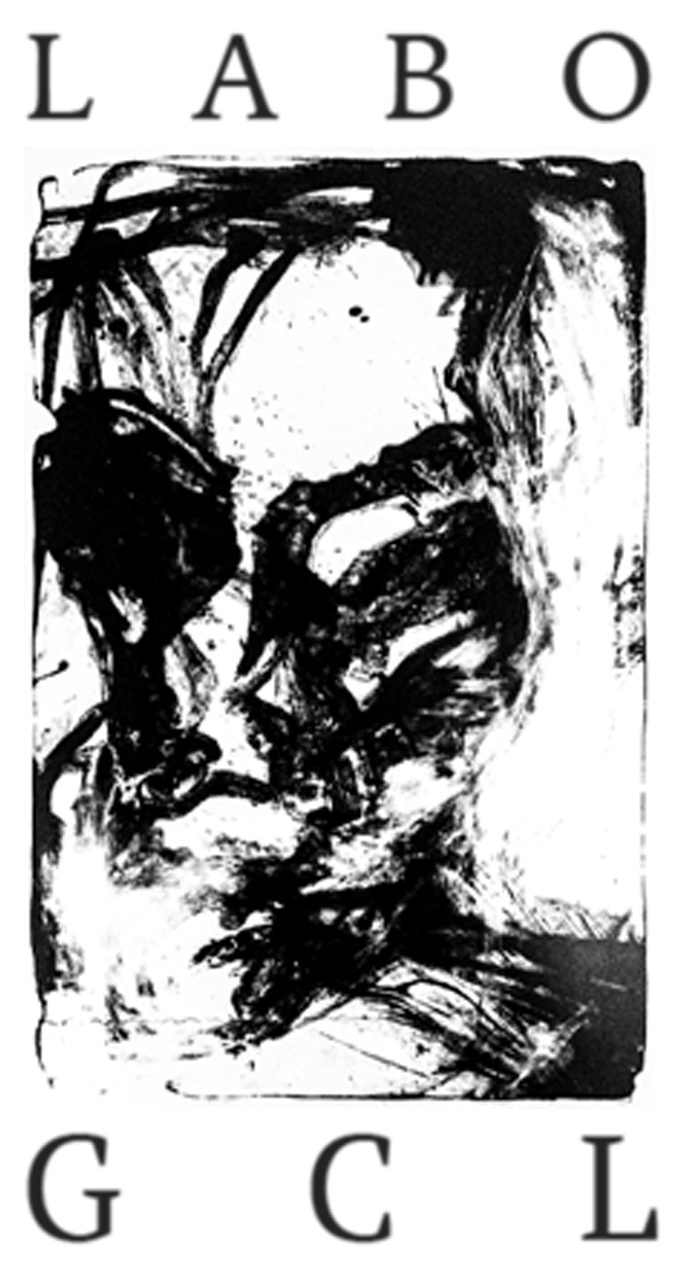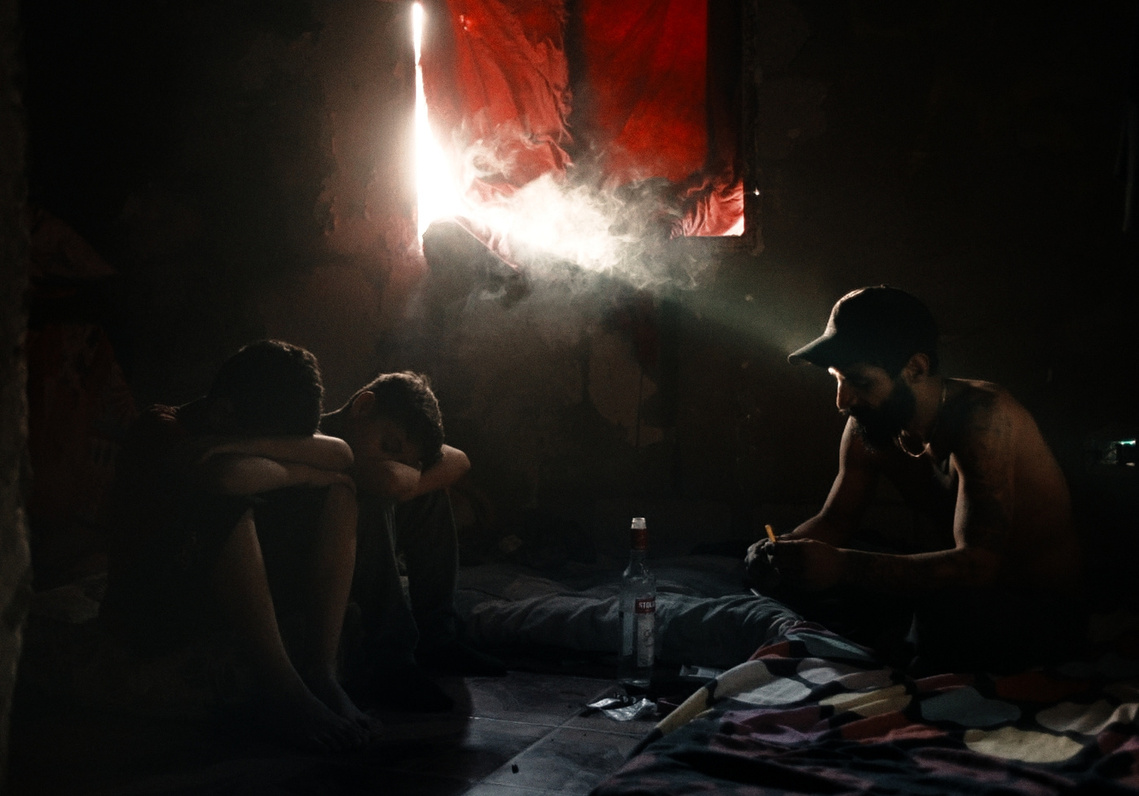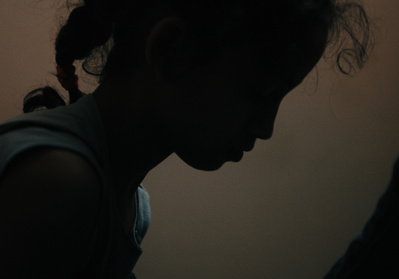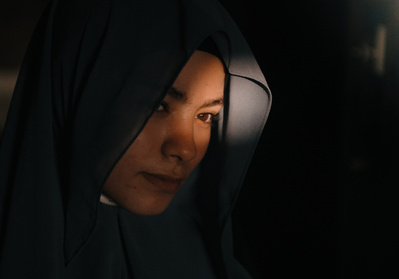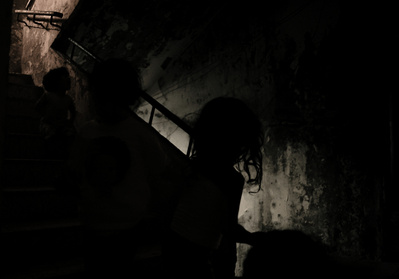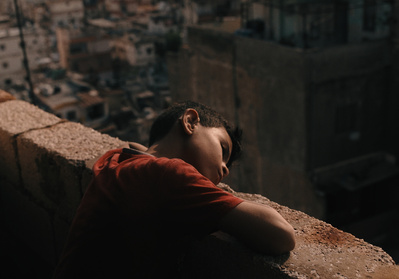A MAN FELL
TRAILER
BRIEF SYNOPSIS
The Gaza Building, a former PLO hospital, is a symbol of Palestinian survival in the refugee camp of Sabra (Beirut) North of Shatila camp.
Across the building’s 11 floors, 11 year-old Arafat spends his time spying at his neighbour, destroying falling parts of the structure and training his dog. Together with his friend Muhammad they think of ways to explore the forbidden underground, where ‘there is only sex, drug and death’.
Meanwhile everyone in the building is talking about the potentially fake story of a man that has just fallen off the 4th floor of the building, the cause being unknown.
THE PROJECT
A MAN FELL was born from chance. On my fourth journey to Lebanon, with the intent of discovering new aspects of the neighbourhood of Shatila, I was faced with unexpected changes in the socio-dynamics surrounding the family Alhaddad (Song of All Ends). After several days looking for new inspiration, I realised that many safe conditions were no longer available to continue my work there, above all: a large increment in drug production and use and the government raids against all Syrians without papers to be removed from the country.
On my first week there I met with Yasser Al Ali, a barber with a shop at the entrance of Sabra. He kindly proposed me to visit a place unknown to me until then: the Gaza Building, where him and his 3 children lived over the past 15 years. We entered its dark staircases one night as he said to me: ‘welcome to hell, Gio’.
From that moment I investigated my possibilities, finally learning some basic Arabic expressions and interacting with the building’s inhabitants from all ages over a period of 25 days. My immediate interest became to portray the dynamics and energy of what can be seen as a monolith of passive resistance of the Palestinian condition.
THE CHARACTERS
There are 8 main characters in the film, with an additional 16 secondary characters, whose stories intersect across the 11 floors of the building.
Our main guide is Arafat, an 11 year old hearing-impaired boy with a strong curiosity for the forbidden. Together with his friend Muhammad they kill time destroying what’s barely left in the building, helping the women carrying clothes between floors and listening sporadically to the many stories they are told. Second comes Jinen, a 17 year old woman, whose main activity is cleaning clothes for the neighbours and finding moments of emancipations with her friends Bissan and Maryam. Bubu is a 27 year old man whose search of some lost playing cards invites us to the lowest level of the drama, the superfluous yet existential aspect of a life deprived of motivations. Nour is a lonely girl, looking after her sister and seeing in the empty walls of the building a way to express her artistic and young political aspirations. Em Esam is the oldest of the inhabitants, and the one who has lived the longest in the building. Her role is that of an unofficial guardian, establishing with charismatic authority a stability between conflicted families. Young Zaheya, together with the local kids, follows up whatever lessons the ladies in the building are able to offer, ultimately finding an escape in the minimal beauty of flowers. Finally Obama, a young man secluded in his apartment on the top floor, consumes his days smoking crystal meth and wondering of an outside world from which he is undeniably excluded.
These characters are all related by one common story: their personal opinion and speculations about a man that just fell from the 4th floor of this very building.
* * *
“Pour lui, l’ombre était un pays secret, plein d’êtres enchantés qui vous font des caresses subtiles
et vous passent les doigts dans les cheveux.”
André de Richaud, La douleur
[For him, the shadows were a secret land, full of enchanted beings who give you subtle caresses and run their fingers through your hair.]
* * *
THE PALESTINIAN CONDITION IN LEBANON
Palestinians in Lebanon include the Palestinian refugees who fled to Lebanon during the 1948 Palestine War, their descendants, the Palestinian militias which resided in Lebanon in the 1970s and 1980s, and Palestinian nationals who moved to Lebanon from countries experiencing conflict, such as Syria. There are roughly 3,000 registered Palestinians and their descendants who hold no identification cards, including refugees of the 1967 Naksa. Many Palestinians in Lebanon are refugees and their descendants, who have been barred from naturalisation, retaining stateless refugee status.
In 2017, a census by the Lebanese government counted 174,000 Palestinians in Lebanon. The United Nations Relief and Works Agency (UNRWA) counted 475,075 registered Palestine refugees as of 31 December 2019. Most Palestinians in Lebanon do not have Lebanese citizenship and therefore do not have Lebanese identity cards, which would entitle them to government services, such as health and education. They are also legally barred from owning property or entering a list of desirable occupations. Employment requires a government-issued work permit, and, according to the New York Times in 2011, although "Lebanon hands out and renews hundreds of thousands of work permits every year to people from Africa, Asia and other Arab countries... until now, only a handful have been given" to Palestinians.
Israeli Arab journalist Khaled Abu Toameh accused Lebanon of practicing apartheid against Palestinian Arabs who have lived in Lebanon as stateless refugees since 1948.
THE GAZA BUILDING
Built in 1978 by the PLO, Gaza Hospital opened in Sabra in 1979. In 1982, the Palestinian Red Crescent Society took over its management. The hospital offered high quality care free of charge to the entire population of Beirut. During the Sabra and Shatila massacre, the staff was evacuated and the facilities were heavily damaged. From 1985 to 1987, during the 'War of the Camps', Gaza Hospital was targeted by the Shia Amal militia supported by the Syrian occupation. In 1988, with the end of the siege of the Palestinian refugee camps in Beirut, the hospital was dismantled and the facilities looted or destroyed. From the surgical blocks, through the electrical system to the elevators, nothing was spared. All that remains of the hospital is an empty shell to which Palestinians flock to find a fragile refuge. Little by little, the hospital has sheltered generations of Palestinian refugees, then Syrians escaping the conflicts, but also poor Lebanese workers as well as Egyptian, Moroccan and Bangladeshi migrants fleeing misery.
Ref: Hans Lucas
LIGHT IMPRISONED IN AN EVERLASTING SHADOW
This is a place where light is lost within its walls and nothing is able to reflect in here. Like a sponge, shadows absorb everything leaving only sharp, brief spaces of brightness. Within these spaces are confined the lives of the inhabitants of the building: an uninterrupted movement between islands of luminance. Only from the 5th floor natural light is allowed, below it a self phone light is needed to cross the stairs and corridors of the building at any time of the day.
At nightfall all is abandoned to complete darkness except for the rare few apartments capable of affording a direct - if only temporarily - connection to a generator and some others able to recharge small led lights with cheap scooter’s batteries. By then those islands of light become even rarer, more separated, indeed more isolated. And the shadows take fully over the air, until the 5 mosques surrounding the building rhythmically remind of the coming of a new day.
CONCLUSIONS ON THE AESTHETICS OF 'A MAN FELL’
I decided to insist on an important symbolic element in the aesthetics of the film: the building’s windows. Windows in this space become an unavoidable source of reflection towards an ‘other world’ from which the inhabitants are excluded.
Yet they are the only source of lights to escape a life otherwise defined by darkness.
As the inside and the outside of the camp are two distinct and separated worlds, the frame of those windows becomes a screen onto which the unreachable is projected, a higher point of view where only imagination can run off.
It was imperative for me that no element of the outside world is ever clearly visible to us, nor is the building itself, as seen by the other side of the camps.
FILM SPECS
Colour 69’ - 1.43:1 - 4K
LANGUAGE
Arabic
English subtitles
DATES
Preproduction: March - May 2023
Production: May - July 2023
Postproduction: 2023-2024
LOCATION
Sabra, Beirut, Lebanon
CINEMATOGRAPHY PROCESS
ProRes 4:2:2 HQ 4K (UHD)
FILM METHODOLOGY
As for my previous works, perhaps even more so in A MAN FELL, I let my instinct and the surroundings define my filmmaking process.
As mentioned above, it was once again by pure chance that I was able to access such a rich and complex environment. After 5 days visiting the different apartments, where many were initially reluctant of getting involved in the project, Yasser and I decided to develop a film based on the seemingly unimportant stories of the building, through the eyes of the young Arafat.
Reducing my usual equipment enabled us to be portable between the building’s 11 floors, where we set to capture immediate moments as well as more prepared scenes with the kids.
I soon discovered that there is drama to spare within Gaza’s walls, and many stories where initially followed and then abandoned on pure moral grounds.
As my introduction to the building was christened by the news of a man falling from the 4th floor just a few instants prior (WhatsApp messages were pouring on everyone’s phone on my first arrival), I thought that that story should be the conductive segment that reunites all others.
We shot for a total of 16 days, plus a final 2 days for sound. Several scenes were re-shot multiple times, mostly when credibility from the main 2 boys was at stake (as imaginable those were exciting and at times boring working days for the young ones). Everyone collaborated on the project, particularly Yasser’s 2 daughters that took care of catering and chaperoning the younger kids, and Yasser himself, who co-produced and co-wrote the film with me, guiding me relentlessly through the maze that is Gaza Building.
HANZALA
Handala (Arabic: حنظلة, romanized: Ḥanẓala), also Handhala, Hanzala or Hanthala, is a prominent national symbol and personification of the Palestinian people.
The character was created in 1969 by political cartoonist Naji al-Ali, and first took its current form in 1973. Handala became the signature of Naji al-Ali's cartoons and remains an iconic symbol of Palestinian identity and defiance. The character has been described as "portraying war, resistance, and the Palestinian identity with astounding clarity”.
Handala's impact has continued in the decades after al-Ali's 1987 assassination; today the character remains widely popular as a representative of the Palestinian people, and is found on numerous walls and buildings throughout the West Bank (notably as West Bank Wall graffiti art), Gaza and other Palestinian refugee camps, and as a popular tattoo and jewellery motif. It has also been used by movements such as Boycott, Divestment and Sanctions and the Iranian Green Movement.
Ref: Wikipedia
THE MUSIC
There are several diegetic tracks throughout the film.
The most prominent is the call for prayer, which comes 4 times throughout the film - 5 times in a day, although we don’t witness the early morning prayer as the film starts mid morning.
There are 2 diegetic radio tracks registered while filming was in process and a third song at the end of the film is written and performed by Katibe 5 (ليل المدينه) - a rap band of Palestinian refugees prolific in the 2000s and still an important reference for many young Palestinians today.
Finally the escaping part is supported by Das Rheingold, WWV 86A - Vorspiel, by Wagner. As the film is mildly inspired by Nietzsche’s Primordial Unity concept, I felt this to be a solid supporter to help relaxing the tension in the film.
